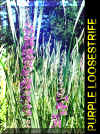
July-Aug
|
Common
Name: Purple Loosestrife



Latin Name: Lythrum salicaria
Family: Lythraceae
This is one of the bad guys of the
invasive world. Although, the flower spike is really quite pretty. Fireweed is
commonly mistaken for purple loosestrife. Purple loosestrife has not reached
everywhere in the U.P. So, if you see it . . . remove it! It's a perennial. |
|

July-Aug |
Common Name: Fireweed


Latin Name: Epilobium
angustifolium
Family: Onagraceae
Fireweed tends to be more pink than purple
loosestrife and the flowers are not as tightly clustered in a spike. Also, fireweed
grows on more upland sites where loosestrife likes the wetland sites. |
|
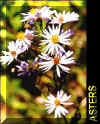
July-Aug-Sept
|
Common Name: Aster

Latin Name: Aster spp.
Family: Compositae
There are about 66 species of aster with
numerous hybrids and many of them are similar-looking! Some flowers can
be reddish or white. Flowers are usually several on a branched stem. Leaf
shapes and plant heights vary. |
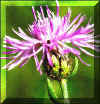
June-Oct |
Common Name: Spotted Knapweed



Latin Name: Centaurea maculosa
Family: Compositae
This is another nasty invasive exotic from
Europe. The genus has many similar species. Knapweed can be easily confused
with wild bergamot. Spotted knapweed arrived in Michigan in the early 1900s and is
usually found on dry sites. Another perennial that is worthy of removal on sight. |

July-Aug |
Common Name: Wild Bergamot, Bee-balm

Latin Name: Monarda fistulosa
Family: Labiatae
Flowers are similar to knapweeds and
(maybe) thistles, but lack the deep "bowl" from which the flower grows out of.
The leaves are opposite each other on the stems. The plant part is greener looking,
softer, and lacks the tough feel of knapweed or the prickles of thistles. |
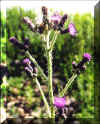
June-Sept |
Common Name: Thistles



Latin Name: Cirsium spp.
Family: Compositae
The tall form of thistles are familiar to
most people. In the U.P., there are about five species and we are more likely notice
the giant bull, Canada, and European swamp thistle before some of the smaller species.
The seed heads contain clusters of wind-borne seeds, easily spreading thistle into
new areas. The prickles are usually very dense, sharp, and long. European
swamp thistle can reach heights of six feet! |
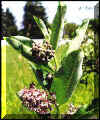
June-Aug |
Common Name: Milkweed


Latin Name: Asclepias spp.
Family: Asclepiadaceae
Most people will recognize milkweed by
their large pods that release wind-borne seeds and their characteristically sticky, white
sap. Milkweeds are common in old fields and disturbed places, so we commonly see
them growing where fields and right-of-ways come right up the roads. |

June-Sept |
Common Name: Alfalfa



Latin Name: Medicago sativa
Family: Leguminosae
Alfalfa has been widely cultivated for
livestock forage and has escaped into the wild. There are three species of Medicago,
all of them exotic. Alfalfa forms a fairly dense patch of vegetation sprinkled with
flower heads of purple blooms. Some petals may be white and there are yellow
varieties across much of the state. |
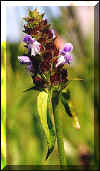
July-Sept |
Common Name: Self-heal

Latin Name: Prunella vulgaris
Family: Labiatae
Self-heal is the only species in its genus
and can be found around the world. It is a member of the mint family, although lacks
any characteristic minty flavor. The small flowers are clustered into flowerheads
that might be an inch or so long. The plant appearance is variable and has a wide
range of habitats. The "side-of-the-road" habitat generally produces a
short, creeping plant not seen unless you are walking along the side of the road and
looking at plants. It's also common in lawns and has learned to keep its head low
enough to avoid the lawnmower blades. Self-heal is an aggressive little plant that
will spread rapidly. |
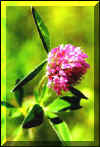
May-Aug |
Common Name: Red Clover

Latin Name: Trifolium pratense
Family: Leguminosae
Originally from Europe and widely
cultivated, red clover is now widespread across most the eastern United States. It
became familiar to most people when they were children. The purple-pink-rarely white
flower heads are large, about an inch across. They are sweet to the taste. The
smaller-headed white clover is also an extremely common plant, also a native of Europe.
There are about ten species of Trifolium in Michigan, many of which are seeded into
openings for whitetailed deer (as if they were rare or something!). |

July-Aug |
Common Name: Bouncing Bet

Latin Name: Saponaria officinalis
Family: Caryophyllaceae
Although this pretty flower is common
throughout the roadsides of the Upper Peninsula, it probably goes unnoticed most of the
time. It's also noted for its habit of commonly growing along railroad tracks.
It can form beds, one to three feet tall, that appear pinkish white in the
sunshine. The single flowers tend to form a loose cluster at the top of the plant.
Several leaves grow in whorls about the stem, but usually one pair of leaves are
much larger than the others. |
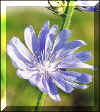
July-Oct |
Common Name: Chicory
  
Latin Name: Cichorium intybus
Family: Compositae
Once this tall flower begins to bloom it
can't be missed, even traveling at 55 miles per hour. It's about the only blue
flower that commonly grows along roads. Blue flowers are rare anywhere, but at 1 to
1-1/2 inches across, these conspicuous baby blue blooms are hard to miss. The green
part of the plant is rather coarse and lacks any particularly outstanding feature other
than a height of 3-4 feet. The taproots have been used to make tea or flavor coffee.
|


![]() An
alien (or exotic species)
An
alien (or exotic species)
![]() Can be easily seen while driving
Can be easily seen while driving
![]() More information
More information